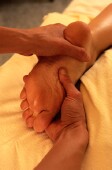
MONDAY, June 20 (HealthDay News) — Millions of Americans suffer from a condition known as peripheral artery disease but aren’t receiving medical treatment, putting them at risk of potentially fatal heart problems, a new study finds.
Those who had the condition but didn’t take medications were more likely to die of all causes during the period studied, although it’s not clear how the disease specifically affected their health, the researchers noted.
The findings, released online June 20 in advance of publication in an upcoming print issue of the journal Circulation, reinforce the belief that peripheral artery disease, or PAD, is an early warning sign of possible clogged vessels elsewhere in the body, said study lead author Dr. Reena L. Pande, a cardiologist and associate professor at Harvard Medical School.
“We think of it as a manifestation of a whole-body problem,” she said. “What happens in the legs can happen in other parts of the body, like the heart and the brain even.”
Atherosclerosis — or blockages in the arteries in the legs caused by plaque — is the source of PAD. Physicians have long known about the condition, but it’s only begun to receive much attention in the last couple of decades, Pande said.
People with the condition may experience cramping in the hips, thighs or calves, pain and burning sensations in the legs, ulcers and even amputation. But in many cases, no symptoms occur.
A simple test of the blood pressure in the arm and the ankle can detect the condition, and there’s debate about whether the test should be routine, said Pande, who is also an associate physician at Brigham and Women’s Hospital in Boston.
In the new study, funded in part by federal grants, Pande and colleagues analyzed statistics from a national survey of 7,458 people aged 40 and older. The participants were tracked from 1999 through 2004.
The researchers found that about 6 percent of the participants suffered from peripheral artery disease, translating to about 7 million adults in the United States. Of those, 25, 36 and 31 percent, respectively, took high blood pressure medication, aspirin or cholesterol drugs.
Those who took two or more of the drugs were 65 percent less likely to die of all causes during the seven years of the study, Pande said. However, she said the percentages of people who died in each group — those who took two or more drugs and those who didn’t — weren’t available.
The research “raises the question of whether we should be looking for these people to get them on the appropriate treatments,” Pande said. “We don’t have any studies that tell us that if we find them and treat them, they’ll have a lowered risk of dying. But it makes us wonder if we should try to find these individuals with a simple screening test.”
The screening test is inexpensive and can be conducted by health care professionals other than doctors, she said. As for cost, at least one of the medications in question — aspirin — is very inexpensive.
Dr. Jeffrey W. Olin, a vascular medicine specialist at Mount Sinai School of Medicine in New York City, said the study provides more evidence that doctors should take peripheral artery disease seriously and treat it. In many cases, he said, doctors don’t prescribe medications even when they know a patient has the condition.
“We’ve been working on this for 15 years, trying to get health care providers to be aware of the fact that people with peripheral artery disease don’t die because of their legs,” he said. “They die because they have heart attacks and strokes.”
More information
For more about peripheral artery disease, visit the U.S. National Library of Medicine.

